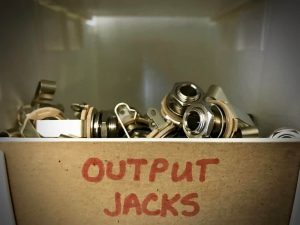
All About Alnico!
In this day and age of the electric guitar, we’ve pretty much seen it all. AlNiCo 2-8, Ceramic, Samarium Cobalt – guitarists and innovators are always trying new things to get different tones – but, what’s the difference between them? How do you choose?
We’ve decided to make a little magnet “Cheat Sheet” for your reference, and experimentation. Let’s start with the basics:
A Magnet is any type of material that produces a magnetic field. Elements like Iron, Nickel, and Cobalt are what is known as Ferromagnetic – an alloy or material containing some iron that can be charged and magnetized to produce a field.
In guitar pickups, we use Permanent Magnets. These are magnets that produce a persistent magnetic field – a field that will keep pulling and pushing, all the time. This can be an alloy (a mixture of metals) – like AlNiCo (Hey! You’ve heard of that!), or, Rare-Earth magnets like Samarium-Cobalt and Neodymium magnets.
We don’t expect you to be an electromagnetic engineer – but what’s the difference tonally? What do they do to your tone?
ALL ABOUT ALNICO:
Alnico is a type of alloy consisting of Aluminum, Nickel, and Cobalt – all mixed with Iron. I’m sure you’ve heard of people using alloys because they make stronger and more efficient metals. For our purposes Alnico is relatively hard to de-magnetize and comes in different strengths as well. These all have an important impact on your tone. Here’s some that we use pretty frequently in our pickups:
ALNICO 2:
Alnico 2 is the second weakest of the Alnico Guitar Magnet strengths, thus it pulls the strings less. It also has what’s referred to as the most “vintage” tone. It has more mids, and more tapered and softer highs than Alnico 3. As a guitar pickup magnet, the lows are loose and bouncy, instead of tight, some might refer to it as “vintage” or “smooth”. We use Alnico 2 in our Pure P.A.F.’s to give them the classic vintage tone we all know.
Alnico 3:
Alnico 3 is the weakest of the Alnico magnets and has the lowest amount of string pull in a bar magnet. As a guitar pickup magnet, it’s lows are soft and bouncy, mids are generally warm and full, and highs are glassy. We use Alnico 3 magnets in our Real 54’s to give them a bright, glassy tone. Curiously, Alnico 3 is weaker than Alnico 2 in a Bar Magnet form, but stronger than Alnico 2 in a Rod Magnet form.
Alnico 4:
Alnico 4 is stronger than both Alnico 2 and 3, but weaker than Alnico 5. It has the most balanced and “even” EQ out of all of the Alnico strengths. The bass and highs are tighter and stronger than Alnico 2, and the midrange is more balanced. We use this pickup in our Modern P.A.F. and P90‘s, and it helps to balance out the overwound properties of them. Alnico 4 has softer highs than Alnico 5.
Alnico 5:
This is by far our most widely used guitar pickup magnet. In it’s rod form, Alnico 5 gives the traditional Fender tone. We use Alnico 5 in all of our Strat, Tele, and Bass pickups. In Fender-style pickups, it has the best balance of extended lows, mids, and highs. Alnico 5 gives that open, airy top-end sparkle that we’re so used to. In Humbuckers, it gives our pickups a brighter tone, which is why we use them in our High Output Humbuckers.
Well, that’s a basic run-down of Alnico, used as a guitar pickup magnet. I hope that helps you decide on some sweet combinations!
Comments
6 Comments For This Post
Leave A Comment
Want to chime in to the conversation? Please do so! Please respect others.







So theoretically one could fine tune a Strat pickup using A2 rods for the first 3 smaller strings to soften the highs then use A5 for the low strings to tighten up the low end.. and give it more definition.. ! Or would that unbalance (to much) the output of the individual strings ?
Seriously? That’s it? What about A6, as used in lipsticks? Would have been interesting to read about those. Or A8’s.
I’m making mag pickups for electric mandolins. A lot of existing mandolin pickups seem to be weak in output for the high E-strings. Mandolins with their comparatively short scale don’t have a lot of physical movement when vibrating. Would it be a waste of time to attempt using an Alnico5 for the E-string(s) and something weaker for the 3 other pairs of strings?
I’ve got some AlNiCo rods. A2, A3, and A5. I’ve also got two 20mm x 10mm N35 neodymium magnets. I tried using the magnets to charge one of the A5 rods and was only able to get it up to about 3-or-so Gauss. I ordered two 40mm x 20mm N52 magnets, hoping that they’ll impart a greater charge. Since they’re both larger and stronger, I imagine they will.
What I’m trying to do is replace, with AlNiCo rods, the steel slugs in some Squier pickups from my friend’s guitar. Those pickups use a bar magnet on the bottom of the bobbin. I was thinking of using A5 in the bridge, A3 for the middle, and A2 for the neck (maybe swapping neck and middle rods, depending on how they sound). My “Gauss meter” is just an app on my phone that uses the magnetometer in my phone to read the Gauss of the magnet. I don’t know how accurate it is, but one of the bar magnets was about 30 Gauss and so were the two N35 magnets together.
I held my phone with the app open over each pickup in my MIM Strat, which has Custom Shop Texas Specials in it. I got about 30 Gauss for the bridge pickup, 20-something for the middle, and between 8 and 10 for the neck pickup. I’m unsure of how trustworthy that latter reading is, but I guess it makes sense since the string vibration there is most intense and thus wouldn’t require as a strong a field as a pickup closer to, or at, the bridge.
All of this is to ask, how powerful should each rod be for each pickup position? Is there a ballpark for which I should be aiming? Are my readings of the Texas Specials accurate? If so, then 5 Gauss per rod for the bridge would be the target, and 3 or so for the neck would be fine. Does that seem right to you? Thanks.
Are the characteristics of alnico grades consistent regardless of how strongly they are charged ?
Many thanks for your time with all this, and your helpful information, much appreciated,
Guy
Hi Tyler
This is good stuff and a sound move clearly explaining many of the basics !
Keep it coming …
Charlie Chandler